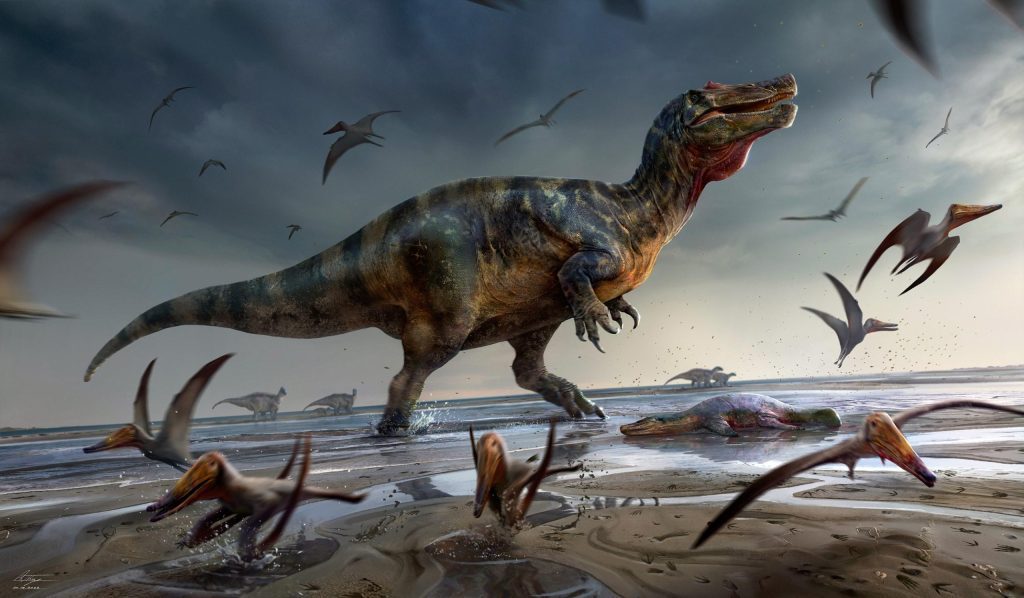
Embora a área de terra seja de apenas 148 milhas quadradas (384 km2), a Ilha de Wight, uma ilha ao largo da Inglaterra, é um dos sítios de dinossauros mais ricos da Europa. De fato, mais de 20 espécies de dinossauros foram encontradas lá desde o início[{” attribute=””>Cretaceous Period, including some which were first identified on the island.
Spinosaurids is a family of carnivorous theropod dinosaurs that originated in the Jurassic period and came to prominence during the Cretaceous period. Paleontologists have found spinosaurid fossils in many locations around the world, including Europe, Asia, Africa, South America, and Australia.
Research led by paleontologists at the University of Southampton has identified the remains of one of Europe’s largest ever land-based hunters: a dinosaur that measured over 10m long and lived around 125 million years ago.
Several prehistoric bones, uncovered on the Isle of Wight, on the south coast of England, and housed at Dinosaur Isle Museum in Sandown, belonged to a type of two-legged, crocodile-faced predatory dinosaur known as spinosaurids. Dubbed the ‘White Rock spinosaurid’ – after the geological layer in which it was found – it was a predator of impressive proportions.
“This was a huge animal, exceeding 10 m in length and probably several tonnes in weight. Judging from some of the dimensions, it appears to represent one of the largest predatory dinosaur ever found in Europe – maybe even the biggest yet known,” said PhD student Chris Barker, who led the study. “It’s a shame it’s only known from a small amount of material, but these are enough to show it was an immense creature.”
The discovery follows previous work on spinosaurids by the University of Southampton team, which published a study on the discovery of two new species in 2021.
The bones of the ‘White Rock spinosaurid’, which include huge pelvic and tail vertebrae, amongst other pieces, were discovered near Compton Chine, on the southwest coast of the Isle of Wight. The Cretaceous rocks are famous for their dinosaurs, but little appreciated is the fact that the Island’s fossil record preserves dinosaurs from more than one section of history – and some of those sections, even today, are poorly known.
“Unusually, this specimen eroded out of the Vectis Formation, which is notoriously poor in dinosaur fossils,” said corresponding author Dr. Neil Gostling, who teaches evolution and palaeobiology at the University of Southampton. “It’s likely to be the youngest spinosaur material yet known from the UK.”
The 125 million-year-old Vectis Formation preserves the beginning of a period of rising sea levels, where the ‘White Rock spinosaurid’ stalked lagoonal waters and sandflats in search of food.
“Because it’s only known from fragments at the moment, we haven’t given it a formal scientific name,” said co-author Darren Naish. He added: “We hope that additional remains will turn up in time.
“This new animal bolsters our previous argument – published last year – that spinosaurid dinosaurs originated and diversified in western Europe before becoming more widespread.”
Marks on the bone also showed how, even after death, the body of this giant probably supported a range of scavengers and decomposers.
“Most of these amazing fossils were found by Nick Chase, one of Britain’s most skilled dinosaur hunters, who sadly died just before the Covid epidemic,” said co-author Jeremy Lockwood, a PhD student at the University of Portsmouth and Natural History Museum. “I was searching for remains of this dinosaur with Nick and found a lump of pelvis with tunnels bored into it, each about the size of my index finger. We think they were caused by bone-eating larvae of a type of scavenging beetle. It’s an interesting thought that this giant killer wound up becoming a meal for a host of insects.”
The researchers hope to generate thin sections of the material to look at the microscopic internal properties of the bones in the near future, which may provide information about its growth rate and possible age.
For more on this discovery, see Europe’s Largest Land Predator Discovered on the Isle of Wight.
Reference: “A European giant: a large spinosaurid (Dinosauria: Theropoda) from the Vectis Formation (Wealden Group, Early Cretaceous), UK” by Chris T. Barker, Jeremy A.F. Lockwood, Darren Naish, Sophie Brown, Amy Hart, Ethan Tulloch and Neil J. Gostling, 9 June 2022, PeerJ.
DOI: 10.7717/peerj.13543








More Stories
Inspetor Geral da NASA emite relatório contundente sobre atrasos no projeto de lançamento da espaçonave SLS
Como os buracos negros ficaram tão grandes e rápidos? A resposta está no escuro
Uma estudante da Universidade da Carolina do Norte se tornará a mulher mais jovem a cruzar as fronteiras do espaço a bordo da Blue Origin